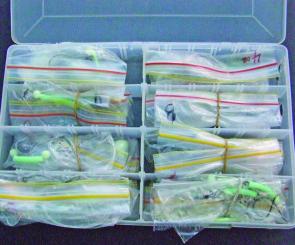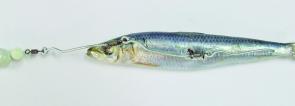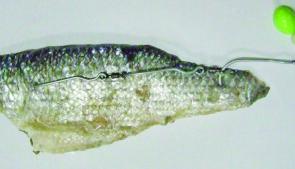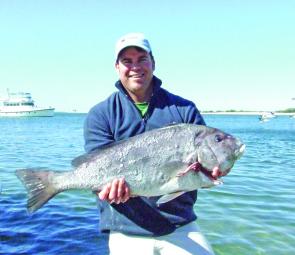This is the first article of five in the Saltwater Series and will tackle the use of gang rigs. I will examine how to make them and how to get the most out of them. I will then discuss the best ways to rig baits when used for reef and deepwater fishing.
Hooks are ganged together to cover the length of the bait to present a natural look to the fish. The old method of ganging hooks together through the eye is still used today. However, many of us find them a little tough to handle. Out of necessity a new method of rigging gangs with a dividing swivel between the hooks has been developed. This makes it easy to place them into any bait.
We all have our favourite hooks and swivels, so just adapt the concept to your liking and preferred equipment. I personally use Tru-Turn hooks and find them one of the sharpest and strongest hooks for ganging. The shogun swivels are also a steadfast recommendation.
The size of the bait is a key feature in deciding what size gang hook to use and the quantity to gang together. Another main feature to consider is the target species. Gang together two hooks, up to six (check your state regulations), to suite the size of the bait and the fish that we are chasing.
Figure A: (4/0 Ganged Hooks straight from the packet)
Figure B: (6/0 Gang hook rig with No 4 swivels in between)
Here is a guide as to what swivel size to use to hook size:
To make the rigs in Figure B open the eyes, ad the swivel and then the additional hook and close the eye fully. If you leave too big a gap the swivel will pull out when under any significant pressure.
The obvious uses of gang hooks are to fish for tailor, salmon, mackerel, mulloway and other pelagics from the rocks, surf and beaches. However, I would like to show you a few other methods for using them.
Gang rigs can be used whilst estuary fishing. You can use two small medium shank hooks to present a herring, hardihead or poddy mullet as a live or dead bait. Do not think they are only for surf and deep-sea fishing. These methods will be covered in more depth in part 3 of the saltwater series. They are also useful to troll both live and dead baits for mackerel, mahi mahi, wahoo, tuna and other species.
You can get to any depth of water by simply adding a sinker to the rig (Figure C). It is important to put a lumo bead or strip between the sinker and the knot on the hook to protect it (Figure C). The sinker can be rigged either on the top of the hooks or above the swivel.
To avoid a stack of snags, I fish with the rig shown as Figure C. When fishing in the estuary or surf I will put the sinker above the swivel. The size of the trace varies between anglers, but 1m of line is all that is necessary. If you use more, the likelihood of snagging the bottom increases tenfold. It is difficult to pull-in enough line when you are going over a pinnacle, so keep it simple and within your control.
We can use gang rigs to present pilchards, whole squid (Figure D), fillets (Figure G), slimies, fish, yakkas and many other baits. Every fisherman has their own method of rigging baits with gang hooks. We have covered the two most popular methods using pilchards, (Figures E & F) and the easiest way to rig squid and a fillet of mullet.
When rigging baits it is important to remember to cover as much of the bait as possible. If you leave an area without a hook, you can bet the fish will chomp that. Squid need to have a hook near the back fins, in the middle and one through the head covering the entire bait. If the bait is too big, trim it down to suite the size of your hooks. The pictured mullet fillet should be trimmed down. It could easily make two baits if cut in half length-ways.
If the fish are holding on the bottom, just add extra weight to get down and hold in the fish area. You are not limited to just bottom fishing with gangs. If you were fishing in 40-90m of water, I would have one rig close to the bottom, one in mid-water, and use one as a floater that is weighted. Use the floater to go down with the berley and pick up any fish that are rising in the berley trail. In summer, use a rig on the surface to pick up any cruising pelagics.
This method often catches the bigger snapper. Try tying a small piece of cloth to the line when you are at the required distance. This will help you to be more accurate as to the depth you want. The alternative is to use the colour line or braid which indicates 10m lots.
The above will now give you the knowledge to make the gang rigs. It also explains how to rig a sinker using the weight needed to get to the target area; how to spread our lines; and how to rig the most common baits to catch fish. There are also other methods of presenting and rigging these baits and we will cover these in Part 2 of the 5 part saltwater series.
Reads: 8724
An organised gang rigs ready to go in different wei.

An original gang hook. (Figure A)

New gang method (Figure B)

Add weight to reach the strike zone (Figure C)

Overhead hooks (Figure E)

Side hooks (Figure F)

Gang on Mullet strip (Figure G)






